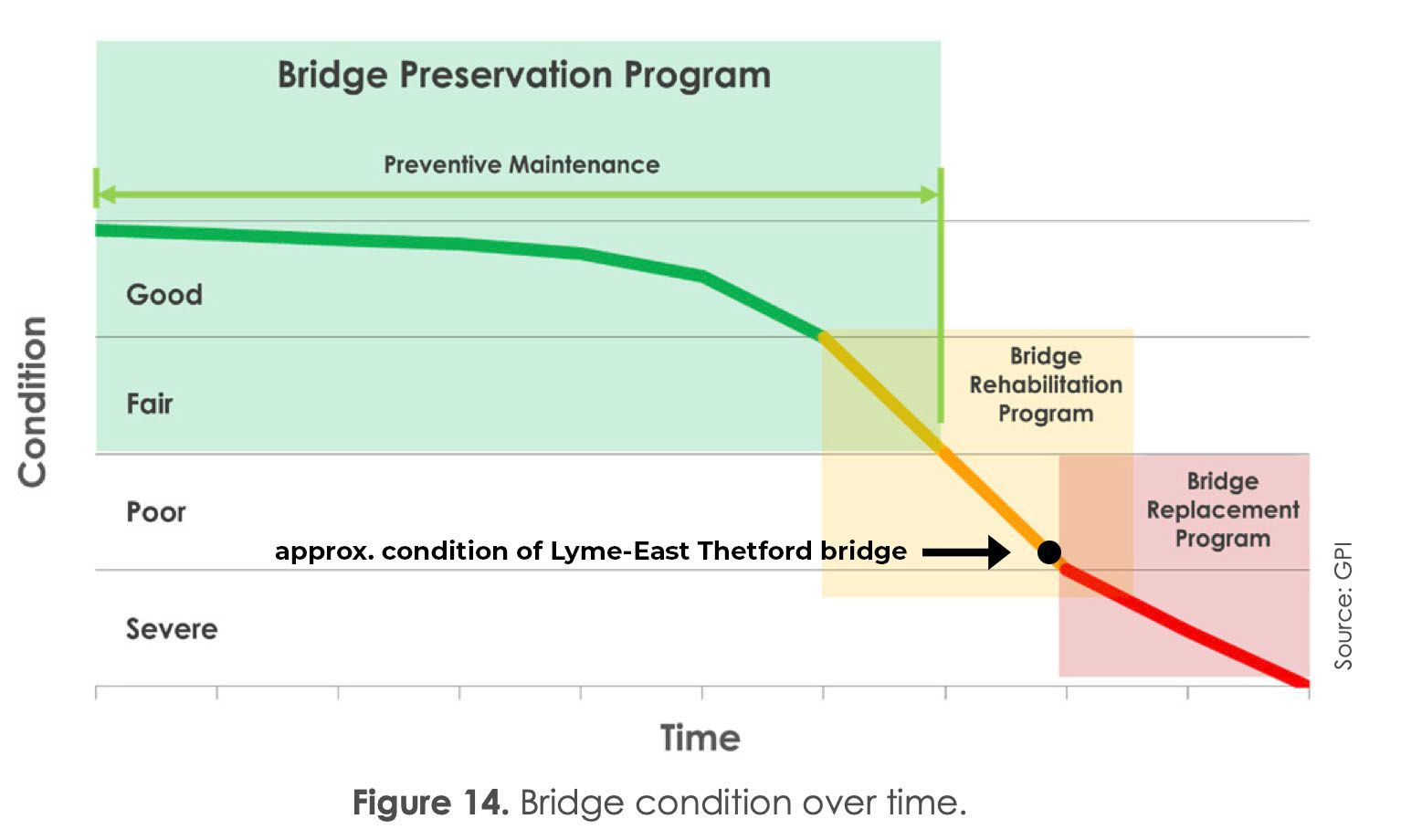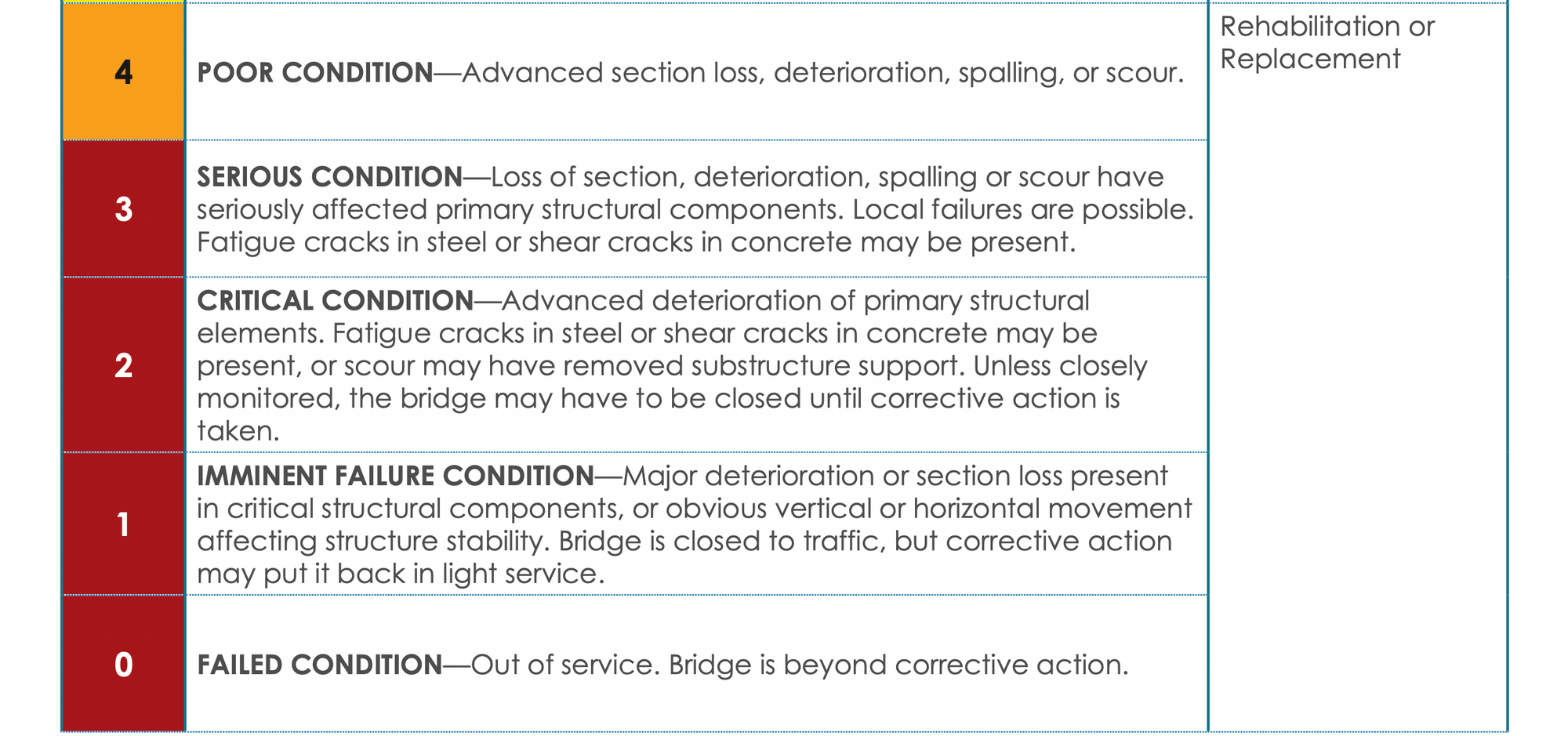Rehabilitate or replace?
The Lyme-East Thetford bridge has a Sufficiency Rating of 31.5%. Replacement might become necessary.

According to the Federal Highway Administration’s National Bridge Inventory, 264,636 (42.3%) of America’s roughly 618,459 bridges are more than 50 years old, and 45,031 (7.3%) of bridges are “structurally deficient” and in poor condition. The Lyme-East Thetford two-span Parker truss bridge is among them.
Cause for concern is that the true condition of the central pier supporting the Lyme-East Thetford bridge is relatively unknown. The 2013 core samples are revealing, showing that “cracking extends at least 8 inches in from the pier surface” and also that the pier is “deteriorating from within.” However, deterioration in concrete is rarely uniform. Did the core samples come from a particularly bad section of the pier or a particularly good section?
When no bids were submitted by contractors to rehabilitate the Lyme-East Thetford bridge in 2021, construction was delayed until 2023. Jennifer Reczek, Project Manager for NHDOT, said over email that, “Contractors cited concerns regarding procuring materials and with the total contract time given current staffing difficulties and the projects they were already committed to work on in 2022.”
It might be easy to focus solely on the labor shortage and supply chains, but Reczek also mentioned concerns about “the total contract time.” The bridge rehabilitation is estimated to take 2.5 construction seasons (including a half season replacing the pier when the bridge would still be open to traffic). The new bridge built to replace the comparable 2-span Parker truss bridge connecting Lancaster, NH and Guildhall, VT was completed in just 18 months.
Granted, every project is unique, but it raises the question: is rehabilitation the more complicated option, and are contractors accepting lower-risk projects over the Lyme-East Thetford one?
“When no bids are received on a project, the Department works with bidders to better understand any potential hesitancy and re-advertises the project,” Reczek said.
The bridge is on the National Register of Historic Places, but contrary to popular belief, that does not mean the bridge cannot be demolished and replaced with a new one. Rather, as Reczek puts it, “This project must comply with Section 4(f) of the US DOT Act of 1966 and 23 CFR 774. Section 4(f) affords resources that are eligible for listing on the National Register of Historic Places with a level of protection by requiring that the feasible and prudent alternative that causes the least harm to the resource(s) be selected for implementation.”
“In this case, bridge rehabilitation is feasible and prudent and therefore, must be selected over a replacement,” Reczek said.
Which means that if rehabilitation was no longer feasible or prudent, the bridge could be replaced, even if it was eligible for or on the National Register of Historic Places.
However, there’s more to consider, such as its impact on other historic resources in the area, including the historic red toll house building on the bridge’s northeast corner, or any other resource that might be in sightline of the bridge and thus suffer an adverse effect from the bridge’s replacement.
In the 2014 and 2015 public hearings in Lyme and Thetford respectively, several questions were asked about NHDOT’s decision to rehabilitate the bridge instead of replace it. For example, “A question was asked if the narrow width was considered. Bob Landry [from NHDOT] stated that the narrow width was considered but with the low traffic count, this was not a significant issue at this location.”
There are other challenges, such as securing right-of-ways. While a temporary right-of-way would be necessary for replacing the central pier for a rehabilitated project (to launch a barge), a new bridge would be wider and require a larger, permanent right-of-way. “Land takings would likely be needed,” the 2015 minutes read.
“It was asked if a cost to benefit analysis was conducted to replace the bridge and also if traffic detour costs were part of the analysis. Bob Landry stated that this was not done because the bridge was historic and could be rehabilitated.”
– 2015 public hearing
A new bridge would cost more too – at least double according to NHDOT’s estimates – not including the cost of removing the current bridge or other environmental impacts.
At a certain point, however, if contractors were to continue to not bid and the bridge were to continue to deteriorate to a condition where it could not be feasibly or prudently rehabilitated, replacement might become unavoidable. According to the USDOT’s Bridge Preservation Guide, that might be sooner than we think.

In short, a bridge should be replaced once its condition moves from “poor” to “serious” or “critical.''

Specifically, if the Lyme-East Thetford bridge showed that “loss of section, deterioration, spalling, or scour have affected primary structural components,” or “local failures [of bridge members] are possible,” then the bridge should be replaced, not rehabilitated.
Sufficiency Ratings are another way to look at a bridge. The rating is based 50% on the bridge’s structural evaluation, 30% on the obsolescence of the design, and 15% on its importance to the public. As of the March 2021 bridge inspection report, the Lyme-East Thetford bridge has a Sufficiency Rating of 31.5%.
The rating is used by the Federal Highway Administration to determine eligibility for funding. A bridge with a rating of less than 80% is eligible for rehabilitation funding, while a bridge with a rating of 50% or below is eligible for replacement funding.
Earlier inspection reports could help us understand the rate of deterioration, such as through changes in the Sufficiency Rating over time, and estimate when replacement might become necessary. While Reczek did provide the most recent March 2021 bridge inspection report upon request, a request for earlier reports went unanswered. A Right to Know request was sent to NHDOT for earlier bridge inspection reports. However, it was answered with, “Based on our initial review [of the request] the NHDOT believes that it will take approximately 30 days to collect, review and redact if necessary, all the documents you have requested. Readily available documents may be sent sooner.”
Replacement wouldn’t be easy on the traveling public. There is insufficient right-of-way for a temporary bridge during construction, which means the crossing would likely still be closed while the current bridge (and pier) was removed and a new bridge was constructed. It might also not suit the aesthetic tastes of many; a new bridge would likely be a single-span flat bridge like the one built connecting Lancaster, NH and Guildhall, VT, or the one connecting Lebanon, NH and White River Junction, VT. Perhaps worse, it could be adorned with concrete balls like Ledyard bridge.
A new bridge might, however, accommodate a sidewalk, a request that has strong public support. Not true of the current bridge. While the wider pier replacement option that NHDOT recommends could support a pedestrian bridge, two 200+ foot spans for a foot bridge would be costly, and the cost might fall to towns. In addition, the effort would likely struggle to obtain the necessary right-of-ways.
